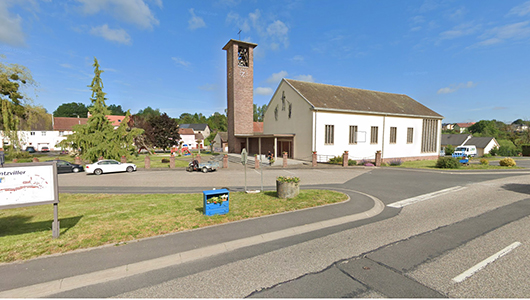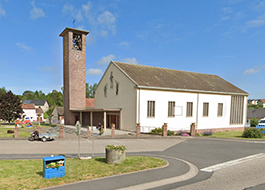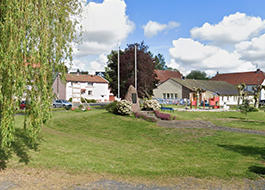Guntzviller
Durée visite : 30 minutes
Moyen : Pédestre
En 699, le village apparaît sous le nom de Villa Gundvino Super Fluvio Biberacha. Les Suédois, alliés de la France de Richelieu, détruisent le bourg en 1635. Il ne renaîtra qu’en 1700, sous l’impulsion de Jacques Krummenacker. Celui-ci y fonde une verrerie qui prospère grâce aux bois environnants. Elle cesse son activité avant 1789. L’agriculture se développe sur les terres ainsi défrichées.
In 699, the village appears under the name of Villa Gundvino Super Fluvio Biberacha. The Swedes, allies of Richelieu’s France, destroyed the town in 1635. It would not be reborn until 1700, under the leadership of Jacques Krummenacker. He founded a glass factory there which prospered thanks to the surrounding woods. It ceased its activity before 1789. Agriculture developed on the land thus cleared.
Im Jahr 699 erscheint das Dorf unter dem Namen Villa Gundvino Super Fluvio Biberacha. Die Schweden, Verbündete von Richelieus Frankreich, zerstörten die Stadt 1635. Sie wurde erst 1700 unter der Führung von Jacques Krummenacker wieder aufgebaut. Er gründete dort eine Glasfabrik, die dank der umliegenden Wälder florierte. Es stellte seine Tätigkeit vor 1789 ein. Auf dem so gerodeten Land entwickelte sich die Landwirtschaft.

Coupé d’or au lion d’azur, armé, lampassé et couronné d’or issant de la partition, et parti d’azur et d’argent.
Au lion de Lutzelbourg, ancien seigneur du lieu, on a ajouté les couleurs du canton suisse de Lucerne pour rappeler que les Lucernois on repeuplé la région après la guerre de Trente Ans.
Per fess Or a lion Azure, armed, langued and crowned Or issuant from the partition, and per pale Azure and Argent.
To the lion of Lutzelbourg, former lord of the place, we added the colors of the Swiss canton of Lucerne to remind us that the people of Lucerne repopulated the region after the Thirty Years’ War.
Pro Fess Oder ein azurblauer Löwe, bewaffnet, schmachtend und gekrönt Oder aus der Teilung hervorgehend, und pro blasses Azurblau und Silber.
Dem Löwen von Lutzelbourg, dem ehemaligen Ortsherrn, haben wir die Farben des Schweizer Kantons Luzern hinzugefügt, um uns daran zu erinnern, dass die Luzerner die Region nach dem Dreißigjährigen Krieg neu besiedelt haben.

Les habitants et les habitantes de Guntzviller s’appellent les Guntzvillerois et les Guntzvilleroises.
The inhabitants of Guntzviller are called Guntzvillerois and Guntzvilleroises.
Die Einwohner von Guntzviller werden Guntzvillerois und Guntzvilleroises genannt.
.

Hapipair — Harossa Hububer
Nous avons trouvé ces termes dans l’ouvrage marqué ci – dessous. Il s’agit, sans doute, d’une interjection onomatopée de caractère local qu’employaient autrefois les voituriers pour faire avancer leur attelage. — Notre enquête n’a pas abouti à un résultat précis.
Hapipair — Harossa Hububer
We found these terms in the book marked below. It is, without doubt, an onomatopoeic interjection of local character that carriers used in the past to move their team forward. — Our investigation did not lead to a definite result.
Hapipair — Harossa Hububer
Wir haben diese Begriffe in dem unten markierten Buch gefunden. Es ist ohne Zweifel ein onomatopoesischer Einwurf lokalen Charakters, den Spediteure in der Vergangenheit benutzten, um ihr Team voranzubringen. — Unsere Untersuchung führte zu keinem eindeutigen.
Les points de visites
.
L’ église de l’Assomption-de-la-Bienheureuse-Vierge-Marie est bâtie en 1726, date de nomination du premier curé desservant. Un nouveau sanctuaire est édifié en 1960. L’Assomption, nommée Dormition dans la tradition orientale, explique que la Vierge Marie, mère de Jésus, au terme de sa vie terrestre, est entrée directement dans la gloire de Dieu, autrement dit montée au ciel. Cette fête fut introduite par l’évêque Cyrille d’Alexandrie au Ve siècle. Elle remplaçait les Feriae Augusti romaines et païennes célébrées mi-août. Cette notion ne devient un dogme qu’en 1950.
The Church of the Assumption-of-the-Bienheureuse-Vierge-Marie was built in 1726, the date of the appointment of the first parish priest. A new sanctuary was built in 1960. The Assumption, called Dormition in the Eastern tradition, explains that the Virgin Mary, mother of Jesus, at the end of her earthly life, entered directly into the glory of God, in other words ascended to heaven. This festival was introduced by Bishop Cyril of Alexandria in the 5th century. It replaced the Roman and pagan Feriae Augusti celebrated in mid-August. This notion only became a dogma in 1950.
Die Kirche Mariä-Himmelfahrt-der-Bienheureuse-Vierge-Marie wurde 1726 erbaut, dem Datum der Ernennung des ersten Pfarrers. 1960 wurde ein neues Heiligtum gebaut. Die Himmelfahrt, in der östlichen Tradition Entschlafung genannt, erklärt, dass die Jungfrau Maria, die Mutter Jesu, am Ende ihres irdischen Lebens direkt in die Herrlichkeit Gottes eingetreten ist, also in den Himmel aufgefahren ist. Dieses Fest wurde im 5. Jahrhundert von Bischof Kyrill von Alexandria eingeführt. Sie ersetzte die römische und heidnische Feriae Augusti, die Mitte August gefeiert wurde. Erst 1950 wurde diese Vorstellung zum Dogma.
.
.
Ce rocher avec plaque et croix latine est en grès rose des Vosges. Il est dédié aux enfants du village morts pendant les deux conflits mondiaux. La quasi totalité des victimes sont des soldats des armées allemandes. Entre 1914 et 1918, 380 000 conscrits Alsaciens et Lorrains ont servi le Kaiser ; seuls 18000 réfractaires choisirent de quitter leurs familles, afin de s’engager dans l’armée française. Pour cette génération, le souvenir de la France était très ténu. Le problème est différent en 1942. La plupart des enrôlés de force sont des « Français de cœur » Aussi parle-t-on de Malgré-nous. 100 000 Alsaciens et 30000 mosellans se retrouvèrent principalement sur le Front de l’Est. 30 000 furent blessés et 10 000 invalides. 30 000 à 40 000 sont morts. Entre 11 000 et 20 000 sont portés disparus, dont 12 000 dans les camps soviétiques. Ici, la famille Krummenacker a été durement meurtrie. Trois membres sont morts en 14-18, quatre en 39-45 et un fut une victime civile, en octobre 1944, à Guntzviller même.
This rock with plaque and Latin cross is made of pink sandstone from the Vosges. It is dedicated to the children of the village who died during the two world wars. Almost all of the victims are soldiers of the German armies. Between 1914 and 1918, 380,000 Alsatian and Lorraine conscripts served the Kaiser; only 18,000 draft dodgers chose to leave their families to enlist in the French army. For this generation, the memory of France was very tenuous. The problem is different in 1942. Most of the conscripts are « French at heart. » So we talk about Despite Us. 100,000 Alsatians and 30,000 Mosellens found themselves mainly on the Eastern Front. 30,000 were injured and 10,000 disabled. 30,000 to 40,000 died. Between 11,000 and 20,000 are missing, including 12,000 in Soviet camps. Here, the Krummenacker family was badly bruised. Three members died in 14-18, four in 39-45 and one was a civilian victim, in October 1944, in Guntzviller itself.
Dieser Felsen mit Tafel und lateinischem Kreuz besteht aus rosafarbenem Sandstein aus den Vogesen. Es ist den Kindern des Dorfes gewidmet, die während der beiden Weltkriege gefallen sind. Fast alle Opfer sind Soldaten der Bundeswehr. Zwischen 1914 und 1918 dienten 380.000 elsässische und lothringische Wehrpflichtige dem Kaiser; Nur 18.000 Wehrdienstverweigerer verließen ihre Familien, um sich der französischen Armee anzuschließen. Für diese Generation war die Erinnerung an Frankreich sehr dürftig. Im Jahr 1942 ist das Problem anders. Die meisten Wehrpflichtigen sind „im Herzen Franzosen.“ Also sprechen wir über „Trotz uns“. 100.000 Elsässer und 30.000 Mosellen befanden sich hauptsächlich an der Ostfront. 30.000 wurden verletzt und 10.000 behindert. 30.000 bis 40.000 starben. Zwischen 11.000 und 20.000 werden vermisst, davon 12.000 in sowjetischen Lagern. Hier wurde die Familie Krummenacker schwer getroffen. Drei Mitglieder starben in den Jahren 14–18, vier in den Jahren 39–45 und eines war ein ziviles Opfer im Oktober 1944 in Guntzviller selbst.







